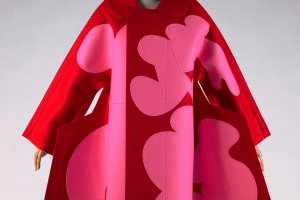Cloth is a two dimensional piece of material. All clothing starts life like this, whether on a sketch pad or a cutting from a roll, and so it is a miracle of creativity to transform it to a wearable item.
At Kyoto Costume Institute they showcase a number of designers who went the other way and deconstructed fashion back to two dimensions. Whether it is clothes that fold into a flat rectangular sheet like reverse origami, or the use of manga to inspire flat two dimensional patterns, visiting their exhibits is a journey from the simple to the complex and back again, as well as from the adult to the childlike. Jun Takahashi, in his Undercover collection in 2007, designed a fluffy bright red dress that looked very feminine, but when you look closely, it is actually dozens of skull patterns stitched together.
At the same time, it is amazing how humble and unobtrusive some of the artisans are, despite designing items of showmanship. Rei Kawakubo of Comme des Garçons rarely gives an interview, never sits at the front of the catwalk, and lives what she believes to be a very ordinary life. When asked for a showing of her workshop, she merely replied that it is just like any other workshop, only more boring. Maybe she was recalling the time when her fashion debuted in Paris in the 1980s, to a press who didn’t understand how baggy black clothes can be considered fashion, and labelled her work as holocaust chic and likening it to the aftermath of a bomb explosion. Her ability to explore what is new and conventional continues despite the passing of time, with a catwalk display of two models walking into a rain shower, to showcase waterproof fashion. The two models then turn their clothes inside out, showing a totally different design on the inside.
These days, however, her fashion is given prime space in cathedral like facilities around the world, with The Future Beauty – 30 years of Japanese Fashion exhibit touring Europe and Australia, its final stop at the Gallery of Modern Art (GOMA) in Brisbane.
The concept of space or ma is widely explored at the exhibition. It is space between the clothes and the person, as well as the idea of shadow and light. References to nature and space abound. Some of the items look like a tree with swaying leaves, where you get a dappled feeling of shadow and light, like the sunlight bathing through the autumn leaves. The shadows that the clothes themselves cast are as magical as the clothes themselves. On the other hand, the unadorned nature of the clothes, made purely from natural fabrics, remind me of the texture of washi paper. Beauty in many handicrafts, from pottery to textiles, is as textural as it is chromatic.
While the fashion here is mainly displayed on mannequins, some are also hung on a wall, like a painting. Many designers here are also interior designers and painters, and some have played in punk bands. So is fashion art after all?

































https://en.japantravel.com/kyoto/kyoto-takashimaya-department-store/2695